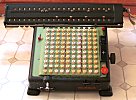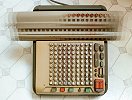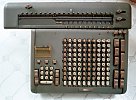Motor driven mechanical models first appeared in the 1900's and had become commonplace on the desks of engineers by the 1940's. While the Comptometer made addition practical and fast, it was these motor driven models that did the same for multiplication and division. (Hand driven machines continued to sell well however because they were quieter, lighter, smaller and less expensive.)
The numeric input keys were still usually arranged as a set of digits per column like the Comptometer. (Although they no longer added as you pressed the digits and had zero or blank keys to fix mistakes.) The accumulator/displays of these machines were mounted on typewriter-like carriages that moved back and forth during multiplies and divides. Divides involved successive subtractions that could take a long time, so DIVIDE STOP was a common key. (Especially useful when an errant operator asked the machine to divide by zero.)
The older Monroe model 1 shown below was electric but still had many manual devices including an exposed operating crank and a manual carriage position crank (on the front left of the machine.) This machine's operation was quite obvious compared to the machines below. It had a divide lever but no multiplication key. Multiplies were done by explicit repeated additions (the + and - keys repeated if held and the "R" key prevented the keyboard from being cleared.)
A multiply/divide switch on the upper right corner of the keyboard controlled the direction of the counter and the two metal levers on the right side of the carriage cleared the upper and lower dials. (The black paddles below the keyboard on the right shifted the carriage left and right - the same function as the crank to the left.)

|
Picture of Monroe Model #1 |
The more modern Monroematic CSA-10 pictured below had three registers on the carriage with keys to enter numbers into (or clear) the appropriate register. It had a negative (but no positive) multiply button and a great many other buttons and switches.

|
Picture of Monroematic CSA-10 |

|
Picture of Monroematic CSA-10 |
The Friden had two registers on the carriage and one on the main body in the multiply section. (This section is to the left in the picture and looked almost like an entire calculator in itself.) The Friden featured keys labeled: MULT, NEG MULT, ACCUM MULT, MULT CLEAR, REP, NON ENT, CTR CON, ADD, +, -, and ENTER DIVD plus two keys identically labeled with the division symbol, shift keys, four unlabeled sliding switches, 20 tiny knobs, 11 thumb wheels and more. In addition each of the numbers 0-9 appeared 10 times in the adding block, once in the multiply block and once on the carriage.

|
Picture of a Friden STW |
The modern looking SCM Marchant's keys included: Back Transfer, Neg Multiply, Rep Neg Multiply carr non shift, carriage tab, middle dial, upper dial and even a key labeled "key board". In addition to these, there were 115 more keys, and 6 switches. It had two registers on the movable carriage and one in the base above the full keyboard. (The museum is looking for a manual for this calculator.)

|
Picture of a SCM Marchant |
![]() Back to early models contents
Back to early models contents
![]() Go on to the Curtas
Go on to the Curtas
![]() Back to the large hand driven models
Back to the large hand driven models